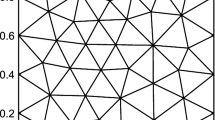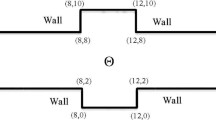Abstract
The Crank–Nicolson (CN) time-stepping procedure incorporating the second-order central spatial scheme is unconditionally stable and strictly non-dissipative for linear convection flows; however, its numerical solution in practice can be oscillatory for nonsmooth solutions. This article studies variants of the CN method for the simulation of linear convection-dominated diffusion flows, in which the explicit convection part is approximated by an upwind scheme, to effectively suppress nonphysical oscillations. The second-order essentially non-oscillatory scheme incorporated in the CN procedure (ENO-CN) has been found effective for a non-oscillatory numerical solution of minimum numerical dissipation. A stability analysis is provided for ENO-CN, which turns out to be unconditionally stable for problems of nonzero diffusion. However, for purely convective flows, it is stable only when the CFL condition is satisfied. Numerical results are presented to demonstrate its stability and accuracy.






Similar content being viewed by others
References
Celia, M.A., Russell, T.F., Herrera, I., Ewing, R.E.: An Eulerian–Lagrangian localized adjoint method for the advection–diffusion equation. Adv. Water Resour. 13(4), 187–206 (1990)
Cho, C.K., Kim, S.: An essentially non-oscillatory Crank–Nicolson procedure for incompressible Navier–Stokes equations. Int. J. Numer. Methods Fluids 56(8), 1351–1357 (2008)
Coppa, G., Lapenta, G., Dellapiana, G., Donato, F., Riccardo, V.: Blob method for kinetic plasma simulation with variable-size particles. J. Comput. Phys. 127(2), 268–284 (1996)
Douglas, J.: Alternating direction methods for three space variables. Numer. Math. 4(1), 41–63 (1962)
Douglas, J., Peaceman, D.: Numerical solution of two-dimensional heat-flow problems. AIChE J. 1(4), 505–512 (1955)
Douglas Jr., J.: On the numerical integration of \(\partial ^2u/\partial x^2+\partial ^2u/\partial y^2=\partial u/\partial t\) by implicit methods. J. Soc. Ind. Appl. Math. 3, 42–65 (1955)
Douglas Jr, J.: Alternating-direction iteration for the p-version of the finite element method. Partial Differen. Equ. Appli. Collect. Pap. Honor Carlo Pucci 121 (1996)
Douglas Jr., J., Kim, S.: Improved accuracy for locally one-dimensional methods for parabolic equations. Math. Models Methods Appl. Sci. 11(09), 1563–1579 (2001)
Ferziger, J.H., Peric, M.: Computational Methods for Fluid Dynamics. Springer, New York (2012)
Freund, R.W.: Conjugate gradient-type methods for linear systems with complex symmetric coefficient matrices. SIAM J. Sci. Stat. Comput. 13(1), 425–448 (1992)
Gunn, J., et al.: A general formulation of alternating direction methods. Part i. Parabolic and hyperbolic problems. Numer. Math. 6, 428–453 (1964)
Harlow, F.H.: The particle-in-cell computing method for fluid dynamics. Methods Comput. Phys. 3(3), 319–343 (1964)
Hockney, R.W., Eastwood, J.W.: Computer Simulation Using Particles. CRC Press, Boca Raton (1988)
Hu, C., Shu, C.W.: A discontinuous galerkin finite element method for Hamilton–Jacobi equations. SIAM J. Sci. Comput. 21(2), 666–690 (1999)
Hughes, T.J., Brooks, A.: A multidimensional upwind scheme with no crosswind diffusion. Finite Elem Methods Convect. Domin. Flows 34, 19–35 (1979)
Hughes, T.J., Franca, L., Mallet, M.: A new finite element formulation for computational fluid dynamics: I. Symmetric forms of the compressible euler and Navier–Stokes equations and the second law of thermodynamics. Comput. Methods Appl. Mech. Eng. 54(2), 223–234 (1986)
Hughes, T.J., Mallet, M.: A new finite element formulation for computational fluid dynamics: IV. A discontinuity-capturing operator for multidimensional advective–diffusive systems. Comput. Methods Appl. Mech. Eng. 58(3), 329–336 (1986)
Jarzbski, A.B., Thullie, J.W.: A stable highly accurate adi method for hyperbolic heat conduction equation. J. Comput. Phys. 63(1), 236–239 (1986)
Jiang, G.S., Peng, D.: Weighted eno schemes for Hamilton–Jacobi equations. SIAM J. Sci. Comput. 21(6), 2126–2143 (2000)
Johnson, C., Pitkäranta, J.: An analysis of the discontinuous Galerkin method for a scalar hyperbolic equation. Math. Comput. 46(173), 1–26 (1986)
Kang, M., Fedkiw, R.P., Liu, X.D.: A boundary condition capturing method for multiphase incompressible flow. J. Sci. Comput. 15(3), 323–360 (2000)
Kurganov, A., Tadmor, E.: New high-resolution central schemes for nonlinear conservation laws and convection–diffusion equations. J. Comput. Phys. 160(1), 241–282 (2000)
Kurganov, A., Tadmor, E.: New high-resolution semi-discrete central schemes for Hamilton–Jacobi equations. J. Comput. Phys. 160(2), 720–742 (2000)
Kwak, D.Y.: A norm estimate for the adi method for nonsymmetric problems. Linear Algebra Appl. 266, 127–141 (1997)
Kwatra, N., Su, J., Grétarsson, J.T., Fedkiw, R.: A method for avoiding the acoustic time step restriction in compressible flow. J. Comput. Phys. 228(11), 4146–4161 (2009)
Lee, B., Kang, M.: Full 3d simulations of two-phase core-annular flow in horizontal pipe using level set method. J. Sci. Comput. 66(3), 1025–1051 (2016)
Leonard, B.P.: A stable and accurate convective modelling procedure based on quadratic upstream interpolation. Comput. Methods Appl. Mech. Eng. 19(1), 59–98 (1979)
Lesaint, P., Raviart, P.A.: On a finite element method for solving the neutron transport equation. Math. Asp. Finite Elem. Partial Differ. Equ. 33, 89–123 (1974)
LeVeque, R.J.: Numerical Methods for Conservation Laws, vol. 132. Springer, New York (1992)
Levy, D., Tadmor, E.: Non-oscillatory central schemes for the incompressible 2-d Euler equations. Math. Res. Lett. 4, 321–340 (1997)
Madden, N., Stynes, M.: Linear enhancements of the streamline diffusion method for convection–diffusion problems. Comput. Math. Appl. 32(10), 29–42 (1996)
Osher, S., Sethian, J.A.: Fronts propagating with curvature-dependent speed: algorithms based on Hamilton–Jacobi formulations. J. Comput. Phys. 79(1), 12–49 (1988)
Osher, S., Shu, C.W.: High-order essentially nonoscillatory schemes for Hamilton–Jacobi equations. SIAM J. Numer. Anal. 28(4), 907–922 (1991)
Peaceman, D.W., Rachford Jr., H.H.: The numerical solution of parabolic and elliptic differential equations. J. Soc. Ind. Appl. Math. 3(1), 28–41 (1955)
Saad, Y., Schultz, M.H.: Gmres: A generalized minimal residual algorithm for solving nonsymmetric linear systems. SIAM J. Sci. Stat. Comput. 7(3), 856–869 (1986)
Shih, Y.T., Elman, H.C.: Modified streamline diffusion schemes for convection–diffusion problems. Comput. Methods Appl. Mech. Eng. 174(1), 137–151 (1999)
Shu, C.W.: High order weighted essentially nonoscillatory schemes for convection dominated problems. SIAM Rev. 51(1), 82–126 (2009)
Smereka, P.: Semi-implicit level set methods for curvature and surface diffusion motion. J. Sci. Comput. 19(1), 439–456 (2003)
Smit, J., van Sint Annaland, M., Kuipers, J.: Grid adaptation with weno schemes for non-uniform grids to solve convection-dominated partial differential equations. Chem. Eng. Sci. 60(10), 2609–2619 (2005)
Staniforth, A., Côté, J.: Semi-lagrangian integration schemes for atmospheric models—a review. Mon. Weather Rev. 119(9), 2206–2223 (1991)
Stone, H.L.: Iterative solution of implicit approximations of multidimensional partial differential equations. SIAM J. Numer. Anal. 5(3), 530–558 (1968)
Strikwerda, J.C.: Finite Difference Schemes and Partial Differential Equations. Siam, Philadelphia (2004)
Van Leer, B.: Towards the ultimate conservative difference scheme. II. Monotonicity and conservation combined in a second-order scheme. J. Comput. Phys. 14(4), 361–370 (1974)
Van Leer, B.: Towards the ultimate conservative difference scheme. V. A second-order sequel to Godunov’s method. J. Comput. Phys. 32(1), 101–136 (1979)
Wang, H., Ewing, R.E., Qin, G., Lyons, S.L., Al-Lawatia, M., Man, S.: A family of Eulerian–Lagrangian localized adjoint methods for multi-dimensional advection-reaction equations. J. Comput. Phys. 152(1), 120–163 (1999)
Warburton, T., Karniadakis, G.: A discontinuous galerkin method for the viscous mhd equations. J. Comput. Phys. 152(2), 608–641 (1999)
Xu, J.J., Zhao, H.K.: An Eulerian formulation for solving partial differential equations along a moving interface. J. Sci. Comput. 19(1–3), 573–594 (2003)
Acknowledgements
Myungjoo Kang is supported by Basic Sciences Research Program through the NRF of Korea funded by the Ministry of Science, ICT and Future Planning (2014R1A2A1A10050531 and 2015R1A5A1009350) and MOTIE (10048720) and IITP-MSIP(No. B0717-16-0107). Seongjai Kim’s work is partially supported by NSF grant DMS-1228337.
Author information
Authors and Affiliations
Corresponding author
Appendix: The Strongly Implicit Procedure (SIP)
Appendix: The Strongly Implicit Procedure (SIP)
The problem (15) in the time level n can be written as the following algebraic system of the form
where the superscript n is omitted for a simpler presentation. To solve it, we adopt the strongly implicit procedure (SIP) suggested by Stone [41]. For completeness of the paper, we briefly describe the basic idea of SIP.
As for other iterative methods, SIP is based on a regular splitting, \(A=M-N,\) with M being an incomplete LU (ILU) factorization;
where \(L_I\) and \(U_I\) are respectively the lower and upper triangular components of an ILU factorization of A, where the entries of the main diagonal of \(U_I\) are all one. Note that the iteration corresponding to the splitting (42) is formulated as
or, equivalently,
where ILU-factorization is carried out by Stone’s SIP [41] .
To make the iteration (43) converge fast, we will choose elements of \(L_I\) and \(U_I\) in a way that N is as small as possible. Let us begin with a 2D problem in a rectangular mesh, where the grid points are ordered in the row-wise manner and the five-point FD scheme is applied. Then, the ILU factorization is in the form shown in Fig. 7 and the row of M corresponding to the \((\ell ,m)\)-th grid point is
Here the subscripts S, W, E, N, and C denote respectively south, west, east, north, and center; which show the relationship of the center point to the adjacent grid points.
The \((\ell ,m)\)-th component of \(N\mathbf{x}\) is
By utilizing the approximations
we can rewrite (46) as
Set each of coefficients in the right-side of (48) to be zero. Then, it follows from (45) that entries of N are presented by those of \(L_I\) and \(U_I\):
Now, utilizing \(M=A+N\), (45), and (49), one can obtain Stone’s ILU factorization [41]:
The SIP (50) deserves the following remarks:
-
The approximations in (47) are second-order accurate when \(\alpha =1\). But in the case, the algorithm (43) incorporating (50) can be unstable; the parameter \(\alpha \) has been chosen between 0.92 and 0.96 for various applications in computational fluid dynamics [9]. Entries of \(L_I\) and \(U_I\) used in (50) whose indices are outside the index boundaries should be set zero.
-
The basic idea of SIP shown for the five-point FD scheme can be applied to nine-point FD schemes, their 3D extensions, and other discretization methods such as finite volume and finite element methods, with minor modifications; although the derivation is so tedious.
Rights and permissions
About this article
Cite this article
Lee, B., Kang, M. & Kim, S. An Essentially Non-oscillatory Crank–Nicolson Procedure for the Simulation of Convection-Dominated Flows. J Sci Comput 71, 875–895 (2017). https://doi.org/10.1007/s10915-016-0324-4
Received:
Revised:
Accepted:
Published:
Issue Date:
DOI: https://doi.org/10.1007/s10915-016-0324-4





